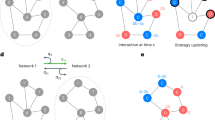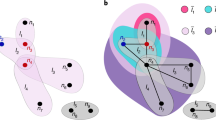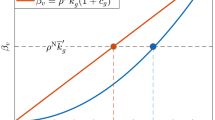Abstract
Cooperation is key to prosperity in human societies. Population structure is well understood as a catalyst for cooperation, where research has focused on pairwise interactions. But cooperative behaviors are not simply dyadic, and they often involve coordinated behavior in larger groups. Here we develop a framework to study the evolution of behavioral strategies in higher-order population structures, which include pairwise and multi-way interactions. We provide an analytical treatment of when cooperation will be favored by higher-order interactions, accounting for arbitrary spatial heterogeneity and nonlinear rewards for cooperation in larger groups. Our results indicate that higher-order interactions can act to promote the evolution of cooperation across a broad range of networks, in public goods games. Higher-order interactions consistently provide an advantage for cooperation when interaction hyper-networks feature multiple conjoined communities. Our analysis provides a systematic account of how higher-order interactions modulate the evolution of prosocial traits.
This is a preview of subscription content, access via your institution
Access options
Access Nature and 54 other Nature Portfolio journals
Get Nature+, our best-value online-access subscription
$29.99 / 30 days
cancel any time
Subscribe to this journal
Receive 12 digital issues and online access to articles
$99.00 per year
only $8.25 per issue
Buy this article
- Purchase on Springer Link
- Instant access to full article PDF
Prices may be subject to local taxes which are calculated during checkout






Similar content being viewed by others
Data availability
All empirical network datasets used in this paper are freely and publicly available at https://icon.colorado.edu/#!/networks (see refs. 55,56,57,58). Source data are provided with this paper.
Code availability
All numerical calculations were performed in MATLAB R2023a. All data analysis were performed in Python 3.10. All computer code developed in this study has been deposited into a publicly available GitHub repository at https://github.com/anzhisheng/Higher-order-interactions (ref. 75).
References
Bavel, JayJ. Van et al. Using social and behavioural science to support COVID-19 pandemic response. Nat. Hum. Behav. 4, 460–471 (2020).
Jacquet, J. et al. Intra-and intergenerational discounting in the climate game. Nat. Clim. Change 3, 1025–1028 (2013).
Tilman, A. R., Plotkin, J. B. & Akçay, E. Evolutionary games with environmental feedbacks. Nat. Commun. 11, 915 (2020).
Perc, Matjaž. et al. Statistical physics of human cooperation. Phys. Rep. 687, 1–51 (2017).
Nowak, M. A. & May, R. M. Evolutionary games and spatial chaos. Nature 359, 826–829 (1992).
Santos, F. C. & Pacheco, J. M. Scale-free networks provide a unifying framework for the emergence of cooperation. Phys. Rev. Lett. 95, 098104 (2005).
Nowak, M. A. Five rules for the evolution of cooperation. Science 314, 1560–1563 (2006).
Ohtsuki, H., Hauert, C., Lieberman, E. & Nowak, M. A. A simple rule for the evolution of cooperation on graphs and social networks. Nature 441, 502–505 (2006).
Lehmann, L., Keller, L. & Sumpter, DavidJ. T. The evolution of helping and harming on graphs: the return of the inclusive fitness effect. J. Evol. Biol. 20, 2284–2295 (2007).
Allen, B. et al. Evolutionary dynamics on any population structure. Nature 544, 227–230 (2017).
Nowak, M. A., Sasaki, A., Taylor, C. & Fudenberg, D. Emergence of cooperation and evolutionary stability in finite populations. Nature 428, 646–650 (2004).
Taylor, P. D., Day, T. & Wild, G. Evolution of cooperation in a finite homogeneous graph. Nature 447, 469–472 (2007).
Tarnita, C. E., Ohtsuki, H., Antal, T., Fu, F. & Nowak, M. A. Strategy selection in structured populations. J. Theor. Biol. 259, 570–581 (2009).
Su, Q., Allen, B. & Plotkin, J. B. Evolution of cooperation with asymmetric social interactions. Proc. Natl Acad. Sci. USA 119, e2113468118 (2022).
Sheng, A., Li, A. & Wang, L. Evolutionary dynamics on sequential temporal networks. PLoS Comput. Biol. 19, e1011333 (2023).
Xia, C., Wang, J., Perc, Matjaž. & Wang, Z. Reputation and reciprocity. Phys. Life Rev. 46, 8–45 (2023).
Rousset, François & Billiard, S. A theoretical basis for measures of kin selection in subdivided populations: finite populations and localized dispersal. J. Evol. Biol. 13, 814–825 (2000).
Rousset, F. Genetic Structure and Selection in Subdivided Populations Vol. 40 (Princeton Univ. Press, 2004).
Santos, F. C., Santos, M. D. & Pacheco, J. M. Social diversity promotes the emergence of cooperation in public goods games. Nature 454, 213–216 (2008).
Perc, Matjaž., Gómez-Gardenes, Jesús, Szolnoki, A., Floría, L. M. & Moreno, Y. Evolutionary dynamics of group interactions on structured populations: a review. J. R. Soc. Interface 10, 20120997 (2013).
Gokhale, C. S. & Traulsen, A. Evolutionary multiplayer games. Dyn. Games Appl. 4, 468–488 (2014).
Mullon, C. & Lehmann, L. The robustness of the weak selection approximation for the evolution of altruism against strong selection. J. Evol. Biol. 27, 2272–2282 (2014).
Peña, J., Nöldeke, G. & Lehmann, L. Evolutionary dynamics of collective action in spatially structured populations. J. Theor. Biol. 382, 122–136 (2015).
Van Cleve, J. Social evolution and genetic interactions in the short and long term. Theor. Popul. Biol. 103, 2–26 (2015).
Benson, A. R., Gleich, D. F. & Leskovec, J. Higher-order organization of complex networks. Science 353, 163–166 (2016).
Battiston, F. et al. Networks beyond pairwise interactions: structure and dynamics. Phys. Rep. 874, 1–92 (2020).
Battiston, F. et al. The physics of higher-order interactions in complex systems. Nat. Phys. 17, 1093–1098 (2021).
Hauert, C., Michor, F., Nowak, M. A. & Doebeli, M. Synergy and discounting of cooperation in social dilemmas. J. Theor. Biol. 239, 195–202 (2006).
Peña, J. & Nöldeke, G. Cooperative dilemmas with binary actions and multiple players. Dyn. Games Appl. 13, 1156–1193 (2023).
Levine, J. M., Bascompte, J., Adler, P. B. & Allesina, S. Beyond pairwise mechanisms of species coexistence in complex communities. Nature 546, 56–64 (2017).
Benson, A. R., Abebe, R., Schaub, M. T., Jadbabaie, A. & Kleinberg, J. Simplicial closure and higher-order link prediction. Proc. Natl Acad. Sci. USA 115, E11221–E11230 (2018).
Ganmor, E., Segev, R. & Schneidman, E. Sparse low-order interaction network underlies a highly correlated and learnable neural population code. Proc. Natl Acad. Sci. USA 108, 9679–9684 (2011).
Milojević, Staša Principles of scientific research team formation and evolution. Proc. Natl Acad. Sci. USA 111, 3984–3989 (2014).
Gambuzza, L. V. et al. Stability of synchronization in simplicial complexes. Nat. Commun. 12, 1255 (2021).
Grilli, J., Barabás, György, Michalska-Smith, M. J. & Allesina, S. Higher-order interactions stabilize dynamics in competitive network models. Nature 548, 210–213 (2017).
Iacopini, I., Petri, G., Barrat, A. & Latora, V. Simplicial models of social contagion. Nat. Commun. 10, 2485 (2019).
Peña, J. & Nöldeke, G. Group size effects in social evolution. J. Theor. Biol. 457, 211–220 (2018).
Peña, J. Group-size diversity in public goods games. Evolution 66, 623–636 (2012).
Peña, J., Wu, B., Arranz, J. & Traulsen, A. Evolutionary games of multiplayer cooperation on graphs. PLoS Comput. Biol. 12, e1005059 (2016).
Li, A., Broom, M., Du, J. & Wang, L. Evolutionary dynamics of general group interactions in structured populations. Phys. Rev. E 93, 022407 (2016).
Su, Q., Zhou, L. & Wang, L. Evolutionary multiplayer games on graphs with edge diversity. PLoS Comput. Biol. 15, e1006947 (2019).
Broom, M. & Rychtář, J. A general framework for analysing multiplayer games in networks using territorial interactions as a case study. J. Theor. Biol. 302, 70–80 (2012).
Gomez-Gardenes, J., Romance, M., Criado, R., Vilone, D. & Sánchez, A. Evolutionary games defined at the network mesoscale: the public goods game. Chaos 21, 016113 (2011).
Peña, J. & Rochat, Y. Bipartite graphs as models of population structures in evolutionary multiplayer games. PLoS ONE 7, e44514–e44514 (2012).
Alvarez-Rodriguez, U. et al. Evolutionary dynamics of higher-order interactions in social networks. Nat. Hum. Behav. 5, 586–595 (2021).
Su, Q., Li, A., Wang, L. & Stanley, H. E. Spatial reciprocity in the evolution of cooperation. Proc. R. Soc. B 286, 20190041 (2019).
Wu, B., Altrock, P. M., Wang, L. & Traulsen, A. Universality of weak selection. Phys. Rev. E 82, 046106 (2010).
McAvoy, A. & Allen, B. Fixation probabilities in evolutionary dynamics under weak selection. J. Math. Biol. 82, 14 (2021).
Gokhale, C. S. & Traulsen, A. Evolutionary games in the multiverse. Proc. Natl Acad. Sci. USA 107, 5500–5504 (2010).
Liu, R. & Masuda, N. Fixation dynamics on hypergraphs. PLoS Comput. Biol. 19, e1011494 (2023).
Peña, J. & Nöldeke, G. Variability in group size and the evolution of collective action. J. Theor. Biol. 389, 72–82 (2016).
Fotouhi, B., Momeni, N., Allen, B. & Nowak, M. A. Conjoining uncooperative societies facilitates evolution of cooperation. Nat. Hum. Behav. 2, 492–499 (2018).
Watts, D. J. & Strogatz, S. H. Collective dynamics of ‘small-world’ networks. Nature 393, 440–442 (1998).
Barabási, Albert-L. ászló & Albert, R. éka Emergence of scaling in random networks. Science 286, 509–512 (1999).
Rogers, E. M. & Kincaid, D. L. Communication Networks: toward A New Paradigm for Research (Free Press, 1981).
Zachary, W. W. An information flow model for conflict and fission in small groups. J. Anthropol. Res. 33, 452–473 (1977).
Davis, A., Gardner, B. B. & Gardner, M. R. Deep South: A Social Anthropological Study of Caste and Class (Univ. South Carolina Press, 2009).
Anderson, C. J., Wasserman, S. & Crouch, B. A p* primer: logit models for social networks. Soc. Netw. 21, 37–66 (1999).
Clauset, A., Newman, MarkE. J. & Moore, C. Finding community structure in very large networks. Phys. Rev. E 70, 066111 (2004).
Wang, J., Fu, F., Wu, T. & Wang, L. Emergence of social cooperation in threshold public goods games with collective risk. Phys. Rev. E 80, 016101 (2009).
Wu, T., Fu, F. & Wang, L. Partner selections in public goods games with constant group size. Phys. Rev. E 80, 026121 (2009).
Szabó, György & Hauert, C. Phase transitions and volunteering in spatial public goods games. Phys. Rev. Lett. 89, 118101 (2002).
Szolnoki, A. & Perc, Matjaž. Group-size effects on the evolution of cooperation in the spatial public goods game. Phys. Rev. E 84, 047102 (2011).
Souza, M. O., Pacheco, J. M. & Santos, F. C. Evolution of cooperation under n-person snowdrift games. J. Theor. Biol. 260, 581–588 (2009).
Civilini, A., Anbarci, N. & Latora, V. Evolutionary game model of group choice dilemmas on hypergraphs. Phys. Rev. Lett. 127, 268301 (2021).
Allen, B., Lippner, G. & Nowak, M. A. Evolutionary games on isothermal graphs. Nat. Commun. 10, 5107 (2019).
McAvoy, A. & Wakeley, J. Evaluating the structure-coefficient theorem of evolutionary game theory. Proc. Natl Acad. Sci. USA 119, e2119656119 (2022).
Wu, B., García, Julián, Hauert, C. & Traulsen, A. Extrapolating weak selection in evolutionary games. PLoS Comput. Biol. 9, e1003381 (2013).
Fortunato, S. Community detection in graphs. Phys. Rep. 486, 75–174 (2010).
Fortunato, S. & Hric, D. Community detection in networks: a user guide. Phys. Rep. 659, 1–44 (2016).
Sheng, A., Su, Q., Li, A., Wang, L. & Plotkin, J. B. Constructing temporal networks with bursty activity patterns. Nat. Commun. 14, 7311 (2023).
Kumar, A., Chowdhary, S., Capraro, V. & Perc, Matjaž. Evolution of honesty in higher-order social networks. Phys. Rev. E 104, 054308 (2021).
McAvoy, A. & Hauert, C. Asymmetric evolutionary games. PLoS Comput. Biol. 11, e1004349 (2015).
McAvoy, A., Allen, B. & Nowak, M. A. Social goods dilemmas in heterogeneous societies. Nat. Hum. Behav. 4, 819–831 (2020).
Initial release of code for research paper ‘Strategy evolution on higher-order networks’. Code Ocean https://doi.org/10.24433/CO.7059083.v2 (2024).
Acknowledgements
We thank A. McAvoy for useful comments and discussions. A.S. acknowledges support from the China Scholarship Council (no. 202206010147). Q.S. acknowledges support from Shanghai Pujiang Program (no. 23PJ1405500). L.W. acknowledges support from the National Natural Science Foundation of China (no. 62036002). J.B.P. acknowledges support from the Simons Foundation Math+X grant to the University of Pennsylvania, and from the John Templeton Foundation (grant #62281).
Author information
Authors and Affiliations
Contributions
A.S., Q.S., L.W. and J.B.P. conceived the project. A.S. derived analytical results and performed numerical calculations. A.S., Q.S., L.W. and J.B.P. analyzed the data. A.S., Q.S. and J.B.P. wrote the main text with input from L.W. A.S. wrote the Supplementary Information.
Corresponding authors
Ethics declarations
Competing interests
The authors declare no competing interests.
Peer review
Peer review information
Nature Computational Science thanks Bin Wu and the other anonymous reviewer(s) for their contribution to the peer review of this work. Primary Handling Editor: Ananya Rastogi, in collaboration with the Nature Computational Science team.
Additional information
Publisher’s note Springer Nature remains neutral with regard to jurisdictional claims in published maps and institutional affiliations.
Extended data
Extended Data Fig. 1 Evolution of cooperation on a variety of higher-order networks.
Cooperation is typically facilitated by higher-order interactions in diverse networks with multiple cliques. a, There are 93 networks that have a size of N = 6 and contain at least one triangle. Two examples are illustrated in the upper panel. For every single network, the critical benefit-to-cost ratios for purely pairwise interactions \({(b/c)}_{(2)}^{* }\) and for higher-order interactions \({(b/c)}_{(2,3)}^{* }\) are calculated, and their difference measures how higher-order interactions influence the evolution of cooperation: \({(b/c)}_{(2)}^{* }-{(b/c)}_{(2,3)}^{* } > 0\) indicates that higher-order interactions facilitate cooperation. For δ2 = 1 and δ2 = 0, the red bars show that higher-order interactions facilitate cooperation for only 6 out of the 93 6-node networks. But when we conjoin two such single networks via a random link (averaging over link placement), then higher-order interactions consistently facilitate cooperation (blue bars). b, Three representative classes of random networks: random regular networks (RR), Watts-Strogatz small-world networks with rewiring probability p = 0.3 (SW)53, and Barabási-Albert scale-free networks (SF)54. For each class, we generated 1,000 networks with size N sampled uniformly from [8, 15] and with average degree sampled in [4,N]. The red bars show the effects of higher-order interactions in these single networks (which facilitate cooperation in less than 50% of cases), whereas the blue bars show the effects of higher-order interactions on two-clique networks generated by connecting two identical networks via the node of highest degree: higher-order interactions facilitate cooperation for all such conjoined networks.
Supplementary information
Supplementary Information
Supplementary Sections 1–5, Figs. 1–14 and Table 1.
Source data
Source Data Fig. 2
Statistical source data.
Source Data Fig. 3
Statistical source data.
Source Data Fig. 5
Statistical source data.
Source Data Extended Data Fig. 1
Numerical data.
Rights and permissions
Springer Nature or its licensor (e.g. a society or other partner) holds exclusive rights to this article under a publishing agreement with the author(s) or other rightsholder(s); author self-archiving of the accepted manuscript version of this article is solely governed by the terms of such publishing agreement and applicable law.
About this article
Cite this article
Sheng, A., Su, Q., Wang, L. et al. Strategy evolution on higher-order networks. Nat Comput Sci 4, 274–284 (2024). https://doi.org/10.1038/s43588-024-00621-8
Received:
Accepted:
Published:
Issue Date:
DOI: https://doi.org/10.1038/s43588-024-00621-8
This article is cited by
-
In search of the most cooperative network
Nature Computational Science (2024)



